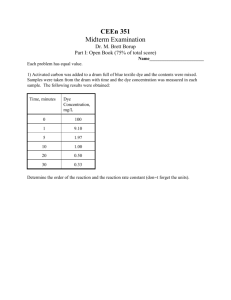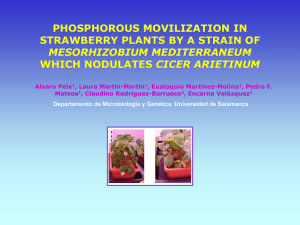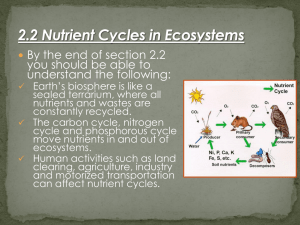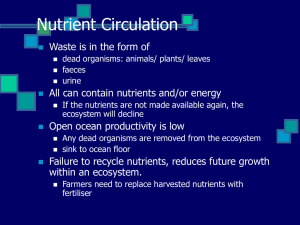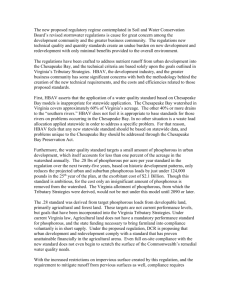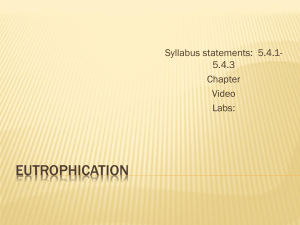Survey of local washing practices and septic tank operation in
advertisement
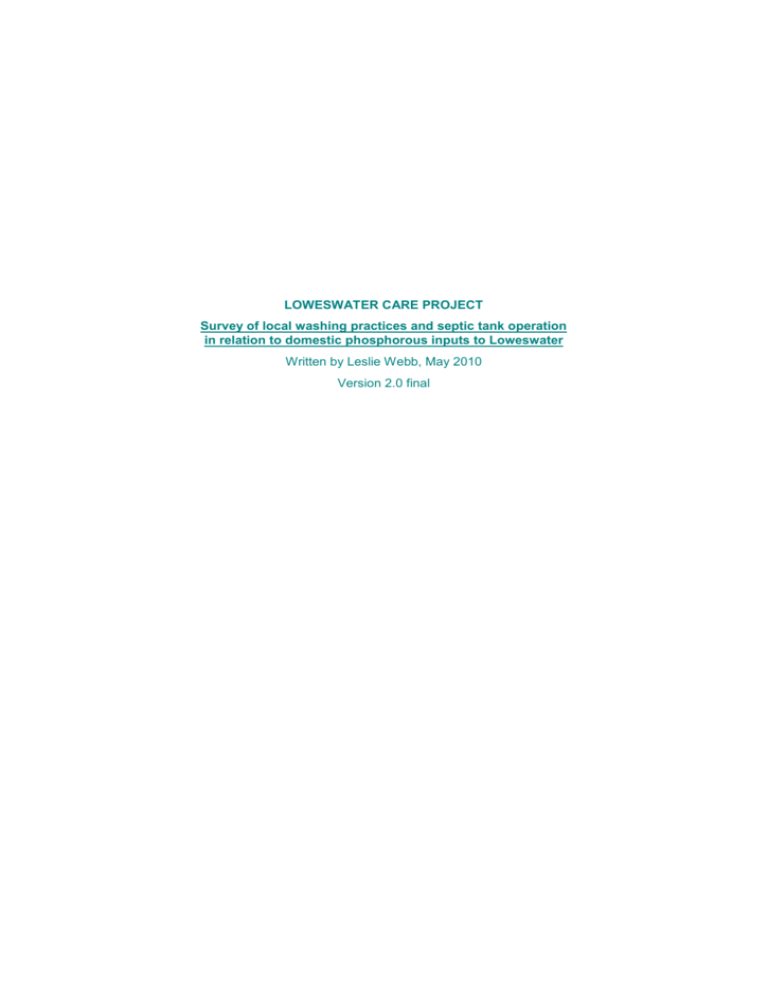
LOWESWATER CARE PROJECT Survey of local washing practices and septic tank operation in relation to domestic phosphorous inputs to Loweswater Written by Leslie Webb, May 2010 Version 2.0 final CONTENTS Page Summary 3 1. Introduction 4 2. Technical background 2.1 Phosphorous compounds 2.2 Sewage treatment 4 5 3. Survey 3.1 Survey coverage 3.2 Survey of laundry and dishwasher detergents and washing practices 3.3 Survey of domestic sewage treatment plants 7 7 8 4. Phosphorous loads from domestic sources discharging to Loweswater 13 5. Conclusions 14 6. Acknowledgements 15 7. References 15 Appendix: Protocol for estimating phosphorous loads from domestic properties 16 -2- Summary This study has surveyed all but one Loweswater property in relation to its use of phosphorous-containing laundry and dishwasher detergents and the operation of all but one of the sewage treatment plants. None of the properties surveyed were found to use laundry detergents containing phosphates – this is not surprising as very few laundry detergents on the market today contain phosphates. This market situation is most likely due to the UK ban on phosphates in laundry detergents due to come into force in 2015. Whilst all properties had laundry washing machines, automatic dishwashers were present at only about 60% of properties. Of these, about 60% used detergents containing more than 30% phosphates. Although the majority of dishwasher detergents do contain high levels of phosphates, there are a reasonable number of phosphate-free dishwasher detergents on the market. There is a range of sewage treatment processes employed at the 18 plants in Loweswater: 7 plants with primary treatment only to remove particulate solids and store the resultant sludge 6 plants with primary treatment followed by secondary treatment in stone bio-filters 1 plant with primary treatment followed by secondary treatment in reed beds and 4 plants with primary and secondary treatment in Biodisc units. Having been installed within the last 5 years, the Biodisc units and reed bed system would be expected to be working satisfactorily as all were well-maintained with adequate sludge removal. The performance at several of the other, older plants is limited by an inadequate frequency of sludge removal and/or by a likely under-performance of the stone bio-filters due to inadequate aeration. In addition, the primary sludge removed from some plants is disposed of within the lake catchment and their phosphorous load could thus still reach the lake. The treated sewage effluents are all discharged to land adjacent to the treatment plants. Phosphorous loads in raw sewage were calculated from published data on average phosphorous loads from human wastes in detergent-free sewage plus a contribution from dishwasher detergents calculated from information collected in this survey. This raw sewage load is estimated to be about 40 kg phosphorous/year compared to 96 kg phosphorous/year assumed in the 2006 study, albeit with a somewhat different contributing population (80 then compared to 63 in this study). The detergent phosphorous is estimated to account for about 5% of the phosphorous in the raw sewage (compared to about 50% in the 2006 study). The net removal of phosphorous from the raw sewage in the treatment plants is estimated to be about 13% at present leaving about 35 kg phosphorous per year discharged in effluents and sludges to land within the lake catchment. Under the most favourable conditions for phosphorus removal/retention within the soil, the overall removal of phosphorous by the treatment systems/land could be as high as about 35%, leaving about 26 kg phosphorous per year that could reach the lake. This assumes no further removal in the soil by chemical adsorption on soil particles or by incorporation in growing plants. The latter could well take place, but the effluent phosphorous would be in competition with phosphorous from any fertiliser applied to land in the vicinity of the sewage disposal points. -3- 1. Introduction This study is one of several being carried out by local people within the framework of the Loweswater Care Project, a community-centred approach to carrying out multi-disciplinary social and technical research. This particular project is aimed at giving the local community a better understanding of the contribution of domestic wastewaters to the problem of excessive algal growth in the lake, the main factor behind which is believed to be the level of available phosphorous compounds. The main sources of phosphorus in the lake are: run-off from land treated with fertilisers animal husbandry in terms of the land spreading of manure and of run-off from farmyards sewage discharges from septic tanks and other treatment plants at dwellings. A previous report on farming practices in Loweswater (1) states that the most obvious management option to reduce the available phosphorus load to the lake is to ensure that all of the septic tanks within the catchment are well-maintained and working efficiently. Key factors determining the phosphorus load from domestic sources are the contribution of domestic washing products to raw domestic phosphorus loads and the efficiency of the installed sewage treatment systems. The project has two elements to investigate this further: a survey of the use of domestic washing products (notably in relation to their phosphorous content) at properties in the lake catchment and of locally-available phosphorous-free domestic washing products a survey of the operational state of the existing septic tanks, notably in relation to their ability to remove phosphorous compounds. Benefits from a successful project are envisaged to be: lowered phosphorous inputs to domestic sewage and outputs from domestic treatment systems recognition by local non-farming residents that they can do something to help mitigation of the algal problem better understanding of key treatment system operational factors to produce best possible quality discharge in terms of suspended solids and oxygen demand as well as phosphorous levels. 2. Technical background 2.1 Phosphorous compounds Phosphorus (P as a chemical symbol) is essential to all forms of life and each human being contains about 0.7 kg, mainly as calcium phosphate, which makes up our bones (and teeth). An average person living in the UK is reckoned to take in 1.1-1.6 grams of phosphorus every day in food (mainly from cereals and dairy/meat products) and drinks, corresponding to an annual intake of 0.4-0.6 kg. Phosphorous occurs naturally mainly in the form of the mineral apatite, which is a slightly different form of the calcium phosphate in bones. Aquatic algae don’t have any bones, but require phosphorus in their cellular processes (as humans and other animals also do) for the internal transfer of energy. Phosphorus is used in many industries: to make phosphate fertilisers (85% of total phosphorus use worldwide) to make phosphate cleaning compounds to make beverages such as Coca Cola (which contains about 0.2% P) to make phosphates used in toothpaste. Most uses of phosphorus are thus in fact the use of phosphates, where phosphorus is combined with oxygen. The simplest phosphate is orthophosphate, where one atom of phosphorus is combined with 4 atoms of oxygen – this is the form in most fertilisers, where it is present as calcium or perhaps ammonium orthophosphate and in Coca Cola, where it is present as orthophosphoric acid. It is this simple type of phosphate that, when present in a soluble form, is most easily available to algae and other life forms. -4- Cleaning compounds are always a mixture of various components, but the key ingredient is a surfactant (surface active agent) that can wet the surface of the article being cleaned, encapsulate the “dirt” and stop it being re-deposited on the article being cleaned. The traditional surfactant is soap, a sodium salt of natural fatty acids, but synthetic surfactants are nearly always used in commercial cleaning products today. In cleaning compounds, phosphorus is occasionally present as orthophosphate, but occurs most commonly as sodium tripolyphosphate (STPP), which can be looked at as three orthophosphate groups joined together. The function of STPP in cleaning compounds is as an auxiliary component (sometimes referred to as a “builder”) to help the surfactant work more effectively by: neutralising the usually adverse effects of hardness in the water (note that this function is hardly necessary in Loweswater due to the very low water hardness) keeping dirt particles dispersed and stopping them re-deposit on the article being cleaned increasing the alkalinity (pH) of the washing water. STPP is used predominantly, but not exclusively, in powder cleaning products for laundry washing machines and automatic dishwashers and is not usually present in liquid cleaners for hand washing of laundry/dishes or in, for example, other cleaning/washing products such as toilet cleaners and hair shampoos. Phosphates like STPP are inorganic phosphate compounds, but there are also some organic phosphorus-containing chemicals (called phosphonates) found in some cleaning compounds. These are very different to the inorganic phosphates, not just chemically, but in the sense that phosphonates are not biodegradable and therefore the phosphorus in them is not available to aquatic organisms like bacteria and algae. (Note that the term “biodegradability” is only applied to organic compounds to denote whether they can be broken down to carbon dioxide and water and not to inorganic compounds like STPP.) The level of STPP in laundry detergents ranges from around 20% in “conventional” products up to about 50% in so-called “compact” (more concentrated) products and in tablets (2). UK manufacturers are required by EU legislation to report the content of listed chemicals within certain ranges (<5%, 5-15%, 15-30% and >30%) so it is impossible to know exact contents without contacting the manufacturer. Because of their well-established contribution to the nutrient enrichment of lakes and consequent excessive algal growth, the use of phosphates in cleaning compounds has been under pressure for some time. A few countries (eg Germany, Netherlands) have outlawed or limited their use in cleaning compounds and this has recently also happened in the UK (3). The UK regulations ban the use of phosphates (but not phosphonates) in domestic laundry cleaners (but not in automatic dishwasher cleaners) from 2015. In advance of this, most UK laundry detergents are already phosphate-free with an estimated 10-17% only still containing phosphates in 2008 (4). There are a number of alternate chemicals to fulfil the same role as phosphates in cleaning compounds, the main ones being zeolites, polycarboxylates, citrates and phosphonates. The last three chemicals are all organic and, as mentioned above, phosphonates do contain phosphorous, but are not biodegradable. Polycarboxylates are also not biodegradable. Citrates are natural chemicals and easily biodegradable. Zeolites are inorganic compounds so the issue of biodegradability is absent. The chemicals that were amongst the first to be considered as phosphate replacements are EDTA, DTPA and NTA, but none has generally been pursued for these applications due to their ability to complex not only hardness salts, but also heavy metals and thus make them more mobile in the environment. 2.2 Sewage treatment Plants for the treatment of sewage from a single dwelling or from a small number of dwellings are based on the same principles as those for larger plants treating the combined sewage from a village, town or city. However, there are particular issues for very small treatment plants such as the potentially high intermittent nature of the flow and the fact that some chemicals (eg bleaches) that are flushed down the drain will not be diluted as much as in a larger system. Both these aspects could have a detrimental effect on the plant performance. -5- Treatment plants are usually broken down into the following treatment stages: preliminary treatment such as screening to remove large solids (eg rags) and removal of grit – these are not normally present at small treatment plants. primary treatment to remove suspended particles, which is always done by simple settlement to form a thick sludge. At a large plant, this would be removed continuously and treated further before off-site re-use or disposal. At small plants, the sludge remains in the tank until it is emptied, which should be done well before the tank is full. secondary treatment to remove materials that would otherwise use up oxygen in the stream to which the treated wastewater is discharged. These substances are measured in a standard laboratory test as the amount of oxygen consumed over 5 days and this is called the Biochemical Oxygen Demand (BOD). The processes used to remove the effluent BOD are all biological in character, using natural bacteria in the wastewater to break down largely organic materials (the same processes that occur in measuring the BOD level in the laboratory). The bacteria responsible for this transformation need oxygen so making sure that the wastewater gets aerated in some way is an important part of this process. This treatment generates more sludge in the form of surplus biomass and this is usually separated in another settlement tank before discharge or further treatment. tertiary treatment typically to remove more of the solid particles than is possible in the previous stage or to remove nutrients such as nitrogen and phosphorous compounds. The sorts of process vary widely from sophisticated chemical treatments to passage over land and/or through planted reed beds. Most wastewater treatment plants are not designed specifically to remove phosphorous, but some removal does occur due to the nature of the phosphorous compounds present and of the processes involved. The primary settling stage removes some of the particulate phosphorous compounds, but none of the phosphates from cleaning compounds as these are soluble. In the biological treatment stage, available phosphorus (such as phosphates from cleaners) is taken up by the bacteria as they grow and incorporated in their biomass. Depending on how much phosphorus comes from detergents, the overall removal in these 2 stages is usually in the range 20-30%. Controlled chemical treatment in a tertiary stage can enhance removals to over 90% if needed. A traditional septic tank treatment system comprising a primary settling stage followed by a stone bio-filter and/or some form of land treatment has the potential to be more efficient at phosphorous removal than a large sewage treatment plant. This is because the bio-filter and land treatment stage involve not only biological treatment utilising natural bacteria, but also the ability of stones and soils to filter and adsorb some of the phosphorous compounds. However, this last effect depends very much on the chemistry of the stones/soils and is most effective when they contain calcium, aluminium and/or iron compounds. Phosphorus removal in so-called “packaged treatment plants” for individual dwellings or small communities would be expected to be similar to that at large sewage treatment works, but, like traditional septic tank systems, they can suffer from one particular problem. This stems from the fact that, in storing the sludges for long periods of time, some of the phosphorus previously-incorporated in the sludge can be re-released into the effluent – this is undesirable, but difficult to stop. This process is similar to that occurring at the bottom of a sometimes stratified lake such as Loweswater. -6- 3. Surveys 3.1 Survey coverage The properties where the treated sewage drains to the lake are clearly defined with the exception of the 3 properties at High Thrushbank, which are usually shown as being outside the lake catchment and of the single Thrushbank property, which is on the boundary line. As three of these 4 properties are second homes/holiday lets, their impact on discharges to the lake is relatively small. In addition, the treated sewage from the 3 properties at Watergate, although clearly within the lake catchment, would probably have a relatively small impact on the body of lake water as they would tend to flow along the nearby shoreline before exiting via the Dub Beck outflow. For completeness, all 7 properties have been included in the survey, but the phosphorous loads have been calculated for 3 scenarios (section 4). All the properties within the lake catchment are summarised in Table 1 in relation to the type of property. It should be noted that some properties changed occupancy during the study period and these are defined as they were in April 2010. Table 1 Details of properties in lake catchment Total number Total surveyed Population equivalents Permanently–occupied dwellings (including long-term lets) 19 18 41.5 Dwellings occupied part-time as second homes/holiday lets 8 7 6.5 Hotels/B&Bs/camping barns 4 4 15 Total number of properties 31 30 63 Number of sewage treatment systems 18 17 63 Types of property Note: The two B&Bs are classified as single properties whereas the private dwellings at the hotel and camping barn are counted separately. 3.2 Survey of laundry and dishwasher detergents and local washing practices This survey is focussing on detergents used in automatic laundry washing and dishwasher machines as these are the main ones using phosphates, notably sodium tripolyphosphate (STPP). A wide range of laundry washing products are on the market, the Sainsbury’s website in April 2010 listing about 100. Of these, just 6 products contained phosphates, although many contained phosphonates (at the <5% level). The products containing phosphates were: Ariel handwash powder; Morrison’s Handwash Nonbio powder; 3 Simply products (all containing 15-30% STPP) and Morrison’s Value Bio powder (containing <5% STPP). All Simply products also possess, perhaps surprisingly, the EU Eco-label for laundry detergents, which denotes a product meeting a range of environmental criteria, but nevertheless does allow the product to contain up to 25% STPP. There may well be other phosphate-containing products on the market from other retailers. All the dwellings surveyed had automatic laundry washing machines, which used a range of laundry detergents. However, none of the dwellings used a laundry detergent containing phosphates either for the machine or for hand washing. One dwelling had an old container of a formerly-used laundry detergent, which contained phosphates at the time of purchase, but no longer does. Given that laundry detergents have historically been the main source of detergent-derived phosphates in domestic sewage (2), this is an important finding in relation to predicting the raw and treated phosphorous loads discharged to Loweswater. About 40% of dwellings surveyed (11 from 30) did not have an automatic dishwasher and thus only used liquid hand-wash detergents, none of which contained phosphates. Of the properties with a dishwasher, several did not use them at all (due to the small number of persons present) or used them sporadically (once or twice per month, mainly when guests were present). About 60% of the dishwashers (10 from 17) used a detergent containing >30% phosphates, whilst the other dishwashers used a phosphate-free product. With the absence -7- of phosphates in the vast majority of UK laundry detergents, automatic dishwasher detergents will already be the main source of detergent phosphates in UK sewage generally and, from this survey, the sole source of detergent phosphorous in the Loweswater catchment. The situation regarding the availability of phosphate-free dishwasher detergents is the converse of that for laundry detergents. This comment does not extend to products for dish washing by hand, all of which are liquid and free from added phosphates. This situation may not change rapidly as there is no foreseeable ban on phosphates in dishwasher cleaners – UK manufacturers were able to convince the government during the recent discussions on the 2010 Detergent Regulations that such a ban would impose insurmountable technical difficulties. Nevertheless, there are a number of dishwasher detergents with no added phosphate including the following - all Ecover products; Sainsbury’s Cleanhome Dishwasher tablets; Morrisons Value Dishwasher tablets; Morrisons Auto Dishwasher tablets; and all Bio D Dishwasher products (available at Booths). As part of the survey, residents were also asked about the frequency of use of dishwashers so that the quantity of detergent could be estimated for use in the procedure outlined in the Appendix. 3.3 Survey of domestic sewage treatment plants The treatment systems and discharge arrangements are classified in Table 2. Table 2 Types of domestic sewage treatment plant Type of treatment plant Plant discharge Number of plants Population equivalents Settlement/sludge storage tank Land soakaway 7 26.5 Settlement/sludge storage tank followed by a stone bio-filter Land soakaway 6 15 Settlement/sludge storage tank followed by reed beds Land soakaway 1 3 Biodisc system Land soakaway 4 18.5 18 63.0 Total Note: the one treatment plant not surveyed is assumed to be as described in the report from the 2004 survey by the Environment Agency All of the properties are connected to some form of treatment system for foul sewage, although some of the wastewaters (from sinks and baths/showers) from 1 or 2 dwellings are not connected to the foul sewerage system. With 1 or 2 exceptions, surface water from roofs have been separated from the foul sewage and discharge to separate soakaways adjacent to the dwellings. All plants discharge to land and not directly to streams or the lake. Other than the Biodisc units (which have integrated settlement/sludge storage compartments), the other 14 treatment plants have stand-alone tanks for settlement of the particulate solids in the raw sewage and storage of the resultant sludge. Of these, 9 units are traditional rectangular brick/concrete septic tanks usually with two separate compartments each 1-2m deep. The other 5 units are more modern tanks, most commonly pre-fabricated plastic tanks with essentially one compartment, but of greater depth than the traditional tanks. Not all of the these tanks are vented positively to atmosphere, although the covering slabs are usually not air-tight so the gases formed from natural breakdown of the sludge (carbon dioxide, methane and hydrogen sulphide) should be able to find their way to the outside atmosphere. The frequency of sludge removal from the tanks is very variable. Sludges from all the Biodisc plants are desludged where necessary at the time of maintenance by outside contractors and are disposed of outside the lake catchment. Information on sludge removal is available from 12 of the 14 other plants, where sludge is removed from just 4 plants at less than 2 year regular intervals. At some plants, sludge is removed at intervals of more than 10 years in the mistaken belief that the sludge solids digest themselves away completely over time. The -8- normal recommendation for septic tanks is for annual desludging irrespective of the plant capacity. Sludges from 5 of the 12 plants are disposed on land within the lake catchment and from 7 plants outside the lake catchment. Excluding the Biodisc treatment plants, half of the others (7 from 14) have no further treatment other than that occurring during percolation through the ground before reaching the lake or one of its feeder streams. Of the other 7 treatment systems, all but one employ a stone bio-filter for a second stage of treatment and the remaining plant uses reed beds. (There was one further stone bio-filter serving a cottage, but the effluent from this was treated further in admixture with the raw sewage from the main house in a Biodisc unit so this is not included separately in the Table 2 summary.) Of the 6 bio-filters, only two could be inspected closely as one was heavily overgrown with grass (Photo 1) and 3 others were covered by heavy slabs that had not been removed for some time. In the absence of any signs of localised ponding/flooding around the overgrown bio-filter, it was unclear how the effluent from the primary settlement tank flowed around or through it to the downstream field soakaway. Even if the effluent did manage to find a way through the stone media, treatment would be severely limited by the absence of any oxygen as the stones were effectively cut off from the air by the overlying soil/grass. The same problem is likely to be present in the other 3 bio-filters covered by slabs. Of the two filters that could be inspected, one had been refurbished within the last 10 years with new limestone media and new distribution troughs (see Photo 2), but no details of the other filter were available as the owners had only been there for about 5 years and were largely absent, as this property is a second home and not frequently used. A problem with bio-filters where the flow of sewage is intermittent is that the bacteria attached to the stones would be starved of food and water for much of the time and thus be in a poor condition to start working when the house is occupied. The distribution troughs in this filter were also broken, thus impairing good distribution of the effluent across the filter when effluent is flowing (Photo 3). Photo 1 Overgrown bio-filter -9- Photo 2 Refurbished bio-filter Photo 3 Intermittently-used bio-filter with broken distribution troughs Even with the refurbished bio-filter, treatment of the incoming effluent is limited to some degree by the difficulty of any oxygen reaching the bacteria growing on any of the stones except those in the surface layer. Bio-filters are used for sewage treatment at quite large sewage treatment works, but are always built above the ground in order to allow air to circulate naturally through the media via ground level openings in the retaining wall. As all the 6 bio-filters in Loweswater are wholly below the ground and all but one covered, adequate oxygenation is unlikely and this will limit to some degree the level of treatment achieved. As summarised in section 2.2, the treatment in such a process is judged by the amount of BOD removed and this is normally in the range 90-95% in a well-operated plant. Phosphorous in the form of phosphate is removed in proportion to the BOD transformed into biomass as the bacteria use the substances measured as BOD as a food source to multiply. Some additional phosphate may also be removed if the stone media is limestone as this can adsorb phosphate on its surface. However, the surface area available is relatively small and quickly becomes saturated, so this removal mechanism cannot be relied on. - 10 - The eco-system in a bio-filter is very broad extending from bacteria through worms and snails to insects and birds. This results in a relatively small overall generation of biomass, which tends to be released from the surface of the stones when the grazing animals return in the spring. As none of the bio-filters in Loweswater has a humus tank to settle these biomass solids, they will be discharged with the effluent to the soakaway. In such circumstances, the phosphorous is thus not removed from the effluent, but is simply discharged in a different form than it was present originally, one that is more likely to be held within the soil than phosphate. The other type of treatment system used by one property in Loweswater as a secondary stage after a stand-alone primary stage is a reed bed (Photo 4). This type of process has been widely used over the last 30 years for the treatment of domestic sewage from small communities. It utilises the natural ability of reeds (most commonly Phragmites australis) to convey oxygen from the air through their roots to the soil, where it is harnessed by natural soil bacteria to oxidise the substances measured as BOD. As in the bio-filter, phosphorous as phosphate is incorporated into the growing biomass, which remains in the soil and eventually forms part of the soil humus. The installed plant in Loweswater is a proprietary design comprising two small reed beds in series. The type of treatment plant installed at 4 locations in Loweswater over the period 2006-7 is the Klargester Biodisc (Photo 5 and Figure 1). This is a so-called packaged plant, which provides complete treatment within the one unit. The raw sewage is settled in the inlet compartment and the settled sewage then passes to the biological treatment stage. The discs are turned slowly, exposing the biomass growing on them alternately to the sewage and to the air. Even in the absence of incoming sewage, this ensures that the biomass growing on the discs is kept wetted and aerated. The bio-treated sewage is finally settled before being discharged from the tank. Photo 4 Reed bed treatment system - 11 - Photo 5 Biodisc in Loweswater designed to handle sewage from a maximum of 6 people Figure 1 Cutaway view of Klargester Biodisc Rotating biological contactors Final settlement zone Primary settlement zone Outlet - 12 - 4. Phosphorous loads from domestic sources discharging to Loweswater In order to estimate the phosphorous discharged to Loweswater from domestic sources, it is necessary to know the phosphorous levels in the raw sewage from each property and the phosphorous removal in the treatment system before the treated sewage reaches the lake. A protocol for estimating the loads of phosphorous in raw and treated sewage is detailed in the Appendix and the results are shown in Table 3. For comparison, the phosphorous loads using in the previous CEH modelling study based on a PE of 80 persons were 96 kg/year for raw sewage and 23 kg/year for the treated sewage from well-operated treatment systems. The most significant result from this study is the much lower phosphorous load estimated for raw sewage due partly to the lower PE measured (63) than previously (80), but mainly to a very low contribution from detergents. The latter amounts to about 5% of the total phosphorous load, whereas data in the previous study implied a detergent phosphorous load of 50% of the total load. The phosphorous load taken in the previous study is consistent with the use of high levels of phosphate-containing detergents for laundry washing (which has historically been the most significant detergent source), whereas this study shows that this contribution in the Loweswater catchment is actually zero. For reference, the phosphorous load in the raw sewage from 80 persons plus the calculated load from detergents would be about 50 kg P/year, ie still very much lower than estimated previously. Removal of phosphorous by primary settlement is always relatively small, but is below average across the 18 Loweswater treatment plants (around 6%) due to two factors: an inadequate frequency of sludge removal at some plants, which allows particulate phosphorous to re-dissolve on prolonged storage in the primary tank and disposal of the primary sludges from some of the plants to land within the lake catchment. Both factors negate any phosphorous removal that does occur on settlement in the first place and, because of this, there is reckoned to be zero net phosphorous removal on primary settlement at 10 of the 18 plants in Loweswater. Table 3 Calculated phosphorous loads from domestic sewage before and after treatment Phosphorous loads (kg/year) Human wastes from kitchens/toilets Crabtree and above Including the 3 Watergate properties Including the 3 Watergate and 4 Thrushbank properties 26.7 33.9 37.8 1.3 2.0 2.1 Total raw sewage 28.0 35.9 39.9 Total phosphorous in existing discharges from treatment systems 23.7 30.8 34.5 Total phosphorous with existing treatment plants and maximum P bio-removal in soil 19.8 25.1 27.9 Loads with efficient primary and secondary treatment at all plants, sludge disposal outside catchment and maximum P bio-removal in soil 18.3 23.6 26.2 Detergents Note: In all cases, it is assumed that, after discharge of the treated effluent to land, there is no chemical removal in soil or usage by growing plants. - 13 - Removal of phosphorous by secondary biological treatment is more significant and is estimated to average 24% at the 6 Loweswater plants (from a total of 11) that are working reasonably well. With the existing poor phosphorous removal on primary treatment, overall phosphorous removal across all 18 treatment plants is estimated to be about 13%, leaving about 35 kg P per year discharged to land in the form of the treated sewage effluents plus the phosphorous in those sludges applied to land within the lake catchment. It is quite possible that further phosphorous could be removed by BOD removal occurring within the soil provided that there is an unsaturated zone above the water table allowing aerobic biological activity. It can be calculated that this would lower the phosphorous load to about 28 kg P per year, corresponding to an overall P removal of 30% across the 18 treatment plants. In the previous two calculations, it has been assumed that the phosphorous in the primary sludges applied to land within the lake catchment would be mineralised and reach the lake. If this phosphorous is not mineralised and remains in the soil (or if the sludges were disposed of outside the lake catchment), the phosphorous load that could reach the lake would be reduced to about 26 kg P per year, corresponding to an overall P removal of 35% across the 18 treatment plants. Removal of phosphorous beyond this level depends on chemical adsorption on soil particles, which is finite and through being incorporated in plant material, ideally grass which would be consumed by growing livestock and leave the lake catchment when they do. It is evident that, despite a small PE, the phosphorous load from the properties at the outflow end of the lake is significant due to an above-average (for Loweswater) use of phosphates in dishwasher detergents and an absence of secondary biological treatment. 5. Conclusions There is no contribution to phosphorous loads in Loweswater raw sewage from phosphates in laundry detergents as all properties use phosphate-free products. There is estimated to be a small contribution (5% of total) to phosphorous loads in Loweswater raw sewage from phosphates in automatic dishwasher detergents. Consequently, the phosphorous load in raw sewage in Loweswater is nearly all accounted for by the phosphorous in normal kitchen and toilet wastes. Together with the lower estimate for the Loweswater population in this study (63 person equivalents) compared to the previous study (80 person equivalents), the small contribution form detergent phosphorous means that the phosphorous load in Loweswater raw sewage (40 kg per year) is much lower than assumed previously (96 kg per year). There are 4 different types of sewage treatment plant represented across the 18 plants in Loweswater, varying from treatment solely by primary settlement of particulate solids to full primary and secondary biological treatment, all treated effluents being discharged to land. Apart from the recently-installed Biodisc units and reed bed, the level of phosphorous removal at several of the other plants is limited either by the absence of biological treatment, by an inadequate frequency of sludge removal, by application of some sludges to land within the lake catchment and/or by a likely under-performance of the stone bio-filters due to inadequate aeration. It is estimated that the net removal of phosphorous from raw sewage is about 13% with the present detergent use, set up of treatment systems and sludge removal/ disposal practices. Under the most favourable conditions for phosphorus removal/retention within the soil (but assuming no chemical removal or uptake by growing plants), the overall removal of phosphorous by the treatment systems/land could be about 35%, reducing the load to about 26 kg P per year. Phosphorous removal beyond this level would require phosphorous uptake by growing plants, where the sewage-derived phosphorous would in competition with that from any phosphate fertiliser spread in that area. - 14 - 6. Acknowledgements The author is grateful to the residents of Loweswater for their co-operation and sparing the time to discuss their washing practices and sewage treatments plants. 7. References 1. Maberly, S et al “An investigation into the potential impacts of farming practices on Loweswater” CEH report to the Rural Development Service and the National Trust (funded through the Rural Enterprise Scheme), Report Number: LA/C02707/4, January 2006. 2. Wind, T “The Role of Detergents in the Phosphate-Balance of European Surface Waters” E-Water (Official Publication of the European Water Association), 2007. 3. The Detergent Regulations 2010, UK Statutory Instrument no 740/2010. 4. Anon “Consultation on options for controls on phosphates in domestic laundry cleaning products in England” DEFRA, 2008. - 15 - APPENDIX PROTOCOL FOR ESTIMATING PHOSPHOROUS LOADS FROM DOMESTIC PROPERTIES The number of people in the catchment has been estimated as an annual average using average or estimated occupancy rates for hotels/B&Bs and letting properties. This is expressed as population equivalents (PEs). The load of phosphorous in raw sewage is largely the sum of that from human wastes and from detergents. Various references report the load from sources other than detergents at 0.5-0.7 kg P per PE per year. A mean value of 0.6 kg P per PE per year has been taken for the calculations in this study. The phosphorous from detergents used within the Loweswater catchment originates solely from the use of phosphate-containing dishwasher detergents at 10 properties. The quantity of phosphorous has been calculated using the reported frequency of dishwasher operation at each property and a typical weight of detergent per wash of 20g (0.02kg). The manufacturer of the market-leading dishwasher detergent brand (Reckitt and Coleman’s Finish) was approached for a more precise figure for its phosphate content, but they did not reply. The phosphate content of all the dishwasher detergents used in Loweswater is reported as >30% so a level of 30% has been taken in these calculations. Total P load in raw sewage (kg per year) = (0.6 x total PE) + (number of dishwasher operations/year x 0.02 x P content of detergent) Most of the phosphorous in raw sewage is present as soluble phosphates so the level of removal in the first stage of sewage treatment (settlement of particulate material) is small. Literature values are 5-15% P removal on primary settlement, but this data is for large sewage treatment works where the sludge is removed from the tank immediately, unlike the tanks at the Loweswater plants where the settled sludge remains there for months (and in some cases, for years). In such situations, phosphorous may be re-dissolved from the sludge as it degrades over time. Where the phosphorous contribution from detergents is lower than average (as at Loweswater), the particulate phosphorous (from human wastes) will be proportionately greater so the level of phosphorous removal would tend to be at the upper end of the range. It is difficult to be precise about the net effect of these various factors, so a mean removal of 10% of the raw phosphorous has been taken for the calculations in this study for those plants where the tank is desludged every 2 years or less. For those plants with longer periods between desludgings, zero phosphorous removal in this stage has been assumed. Where sludge from primary settlement/sludge storage tanks is applied to land within the lake catchment, the net phosphorous removal from these tanks is assumed to be zero as the phosphorous remains in the lake catchment. The level of phosphorous removal in the secondary biological stage of treatment (where present) depends on the net growth of biomass in the stone bio-filters, reed bed or Biodisc plants. The growth of biomass is related to the BOD level in the sewage, the standard UK figure for which is 0.06 kg per PE per year. About 30% of the BOD is typically removed on primary settlement, leaving about 0.042 kg per PE per year passing to the secondary stage of treatment. Phosphorous removal occurs in direct relation to the BOD level and a figure of 1% of the BOD removed is normal. The BOD removal in the various treatment plants has been assigned a level appropriate to its likely efficiency from the survey, as follows: - 90% for Biodisc plants and reed bed - 80% for well-maintained stone bio-filters - 0% for poorly-maintained stone bio-filters. In the Biodisc units, the effluents are settled to remove the biomass solids before being discharged to land. In the stone bio-filters, the biomass is not retained on the stone surfaces indefinitely, but is released periodically into the effluent. There is no further settlement so the bio-filter effluent contains all the phosphorous that has been converted to biomass plus the residual, non-converted soluble phosphates present initially. Effectively therefore, there is no removal of phosphorous as it has simply been converted from one form to another and remains in the effluent. In a worst-case scenario, zero net phosphorous removal is assumed prior to discharge to land, even in the bio-filters that function well. In a best-case scenario, it is - 16 - assumed that the biomass phosphorous is retained within the soil and thus removed from the effluent that eventually reaches the lake. Sludges (both primary and secondary) from the Biodisc units are tankered outside the lake catchment, so their phosphorous load has genuinely been removed. In the reed bed plant, a proportion of the soluble phosphorus is again converted to biomass, which should be retained within the soil growing medium so is again considered to have been removed from the discharge. For the stone bio-filters, no further phosphorous removal by chemical adsorption on the stones has been assumed. All the treated effluents are discharged to land and their phosphorous load is thus available as a nutrient to support biological activity (growth of soil bacteria and grass/plants) in the application area. Any phosphorous associated with particulate solids should be filtered out close to the application point, but removal of dissolved phosphorous will depend on the level of biological activity and the availability of phosphorous from other sources (slurry and fertiliser) as it percolates towards the lake. There is no firm basis for predicting the removal of phosphorous via chemical and biological mechanisms occurring within the soil and no further phosphorous removal has therefore been assumed. It should be noted that the effluent phosphorous is in the same chemical form (orthophosphate) as that in any added fertilisers. However, phosphate in fertilisers can be present as the poorly–soluble calcium salt (rock phosphate) or as the soluble ammonium salt. The sewage phosphate would be more readily available to the growing crop than phosphate rock and comparable to that in ammonium phosphate. - 17 -
